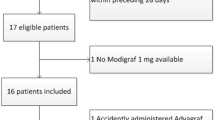Abstract
An improved model describing receptor/gene-mediated pharmacodynamics of prednisolone is presented which consists of seven differential equations. Data for plasma prednisolone concentrations, free hepatic glucocorticoid receptors, and hepatic tyrosine aminotransferase activity (TAT) following low (5 mg/kg) and high (50 mg/kg) doses of prednisolone are used to quantitate the kinetics and dynamics of this synthetic steroid in the rat. In contrast to the earlier model, the newer model provides for a coupling and simultaneous fitting of receptor and TAT data and is able to describe the recycling of receptors between cytosol and nucleus and the return of cytosolic receptors to baseline following glucocorticoid elimination. A numerical technique to determine the efficiency of TAT induction based on area under the curve calculations is presented, which supports the hypothesis that nonlinear dose-response effects are due to dose and time-dependent receptor depletion in the cytosol. Simulations are presented to examine the major determinants of corticosteroid effects and to compare the effects of single-and multiple-dose regimens in maximizing drug effects.
Similar content being viewed by others
References
L. B. Sheiner, D. R. Stanski, S. Vozeh, R. D. Miller, and J. Ham. Simultaneous modeling of pharmacokinetics and pharmacodynamics: Application tod-tubocurarine,Clin. Pharmacol. Ther. 25:358–371 (1979).
N. H. G. Holford and L. B. Sheiner. Pharmacokinetic and pharmacodynamic modeling in vivo.Crit. Rev. Bioeng. 5:272–322 (1981).
R. Ellul-Micallef. The acute effects of corticosteroids in bronchial asthma.Eur. J. Respir. Dis. 63:118–125 (1982).
B. M. Frey, C. Walker, F. J. Frey, and A. L. deWeek. Pharmacokinetics of three different prednisolone prodrugs: effect on circulating lymphocyte subsets and function.J. Immunol. 133:2479–2487 (1984).
F. D. Boudinot, R. D'Ambrosio, and W. J. Jusko. Receptor-mediated pharmacodynamics of prednisolone in the rat.J. Pharmacokin. Biopharm. 14:469–493 (1986).
A. Munck and K. Leung. Glucocorticoid receptors and mechanisms of action of steroid hormones. In J. R. Pasqualini (ed.),Receptors and Mechanisms of Action of Steroid Hormones, Marcel Dekker, New York, 1977, pp. 311–397.
M. Izawa, A. Yosida, and S. Ichii. Dynamics of glucocorticoid receptor and induction of tyrosine aminotransferase in rat liver.Endocrinol. Japan.29:209–218 (1982).
G. G. Rousseau. Control of gene expression by glucocorticoid hormones.Biochem. J. 244:1–12 (1984).
J. Gustafsson, J. Carlstedt-Duke, L. Poellinger, S. Okret, A. Wikstroom, M. Bronnegard, M. Gillner, Y. Dong, K. Fuxe, A. Cintra, A. Harfstrand, and L. Agnati. Biochemistry, molecular biology and physiology of the glucocorticoid receptor.Endocrinol. Rev. 8:769–775 (1987).
P. S. Olson, E. B. Thompson, and D. K. Granner. Regulation of hepatoma tissue culture cell tyrosine aminotransferase messenger ribonucleic acid by dexamethasone.Biochemistry 19:1705–1711 (1980).
K. B. Bischoff, R. L. Dedrick, D. S. Zaharko, and J. A. Longstreth. Methotrexate pharmacokinetics.J. Pharm. Sci. 60:1128–1133 (1971).
C. M. Metzler, G. K. Elfring, and A. L. McEwen. A package of computer programs for pharmacokinetic modelingin vivo.Biometrics 30:562–563 (1974).
H. G. Boxenbaum, S. Riegelman, and R. M. Elashoff. Statistical estimation in pharmacokinetics,J. Pharmacokin. Biopharm. 2:123–148 (1974).
A. Munck and N. J. Holbrook. Glucocorticoid-receptor complexes in rat thymus cells: rapid kinetic behavior and a cyclic model.J. Biol. Chem. 259:820–831 (1984).
A. Munck and N. J. Holbrook. Steroid hormone antagonism and a cyclic model of receptor kinetics.J. Steroid Biochem. 26:173–179 (1987).
W. R. McIntyre and H. H. Samuels. Triamcinolone acetonide regulates glucocorticoid receptor levels by decreasing the half-life of the activated nuclear-receptor form.J. Biol. Chem. 160:418–427 (1985).
A. Yosida, T. Noguchi, S. Taniguchi, Y. Mitani, M. Ueda, K. Urabe, T. Adachi, Y. Okamura, C. Shigemasa, K. Abe, and H. Mashiba. Receptor dynamics and tyrosine aminotransferase induction during the course of chronic treatment of rats with glucocorticoids.Endocrinol. Japan. 33:769–775 (1986).
A. Kong, E. A. Ludwig, R. L. Slaughter, P. M. Gannon, E. Middleton, and W. J. Jusko. Pharmacodynamic modeling of rapid effects of methylprednisolone in man.Pharmaceut. Res. 5:5–149 (1988).
Author information
Authors and Affiliations
Additional information
Supported in part by Grant 24211 from the National Institutes of General Medical Sciences, National Institutes of Health.
Rights and permissions
About this article
Cite this article
Nichols, A.I., Boudinot, F.D. & Jusko, W.J. Second generation model for prednisolone pharmacodynamics in the rat. Journal of Pharmacokinetics and Biopharmaceutics 17, 209–227 (1989). https://doi.org/10.1007/BF01059029
Received:
Revised:
Published:
Issue Date:
DOI: https://doi.org/10.1007/BF01059029




